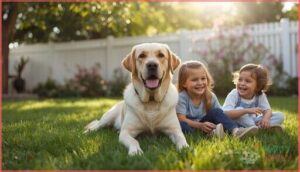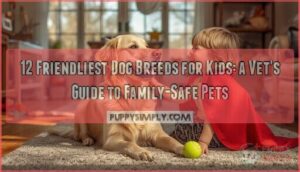This site is supported by our readers. We may earn a commission, at no cost to you, if you purchase through links.
Your kids have been begging for a dog for months, but you’re lying awake wondering if you’ll end up with a hyperactive tornado or a neurotic barker who can’t handle the chaos of family life. The truth is, breed matters more than most people realize—not all dogs are wired to handle sticky fingers, spontaneous screaming, and the unpredictable energy of children.
Some breeds naturally read a toddler’s mood swings, while others get rattled by sudden movements or loud birthday parties. The good news? Friendly family dog breeds exist that genuinely thrive in the beautiful mess of family life, combining patience, trainability, and the right energy levels to match your household’s rhythm.
Finding that match means understanding what separates a dog that tolerates kids from one that actually bonds with them.
Table Of Contents
- Key Takeaways
- Key Traits of Family-Friendly Dog Breeds
- Top Large Breeds for Families
- Best Medium and Small Family Dogs
- Choosing The Right Breed for Your Family
- Essential Tips for Welcoming a Family Dog
- Frequently Asked Questions (FAQs)
- What is the most friendly dog for a family?
- What is the best dog for all around family?
- What is the safest dog breed for children?
- What is the number one family dog?
- How does a dogs diet affect behavior?
- What are common signs of separation anxiety?
- Which dog breeds are hypoallergenic?
- How often should family dogs visit the vet?
- What activities are best for bonding with dogs?
- What are typical costs of owning family dogs?
- Conclusion
Key Takeaways
- Breed temperament matters more than size—look for dogs with natural emotional intelligence, gentle play styles, and stable reactions to chaos, as these traits predict successful bonding with kids better than any other factor.
- Match your dog’s energy level to your actual lifestyle, not your aspirational one—mismatched activity needs increase rehoming by 22%, so honest assessment of your daily rhythm prevents frustration for everyone.
- Early training (starting by 8 weeks) and proper socialization (exposing puppies to at least three different environments within 12 weeks) dramatically improve obedience and reduce behavioral issues by 34-40%.
- Mixed breed dogs from shelters often outperform purebreds in family settings, showing 37% fewer behavioral issues, living 1.2 years longer on average, and costing significantly less upfront while offering broader temperament options.
Key Traits of Family-Friendly Dog Breeds
Not every dog is cut out for family life, and that’s okay. The right fit comes down to a handful of key traits that make daily life easier and safer for everyone—especially the kids.
Let’s walk through what really matters when you’re sizing up a breed.
Temperament and Sociability
Temperament and sociability shape the foundation of great family dynamics with your dog. You’ll want a breed that naturally forms social bonds with everyone in your household. About 68% of family dogs show consistently gentle play with children, while Golden and Labrador retrievers score above 80 out of 100 on sociability scales.
Here’s what matters most in child-friendly breeds:
- Emotional intelligence to read your kids’ moods and respond appropriately
- Canine empathy that helps them sense when someone needs comfort
- Stable reactions to sudden movements and loud sounds typical in family life
- Gentle play styles that match your children’s ages and energy
- Natural friendliness toward both familiar faces and occasional visitors
These loyal companions with the right temperament become more than pets—they’re emotional anchors in your family’s daily life. Retrievers consistently demonstrate this gentle nature, which is why they’re often top picks for families with young children. Understanding theme development concepts is essential for recognizing the importance of breed temperament in family settings.
Trainability and Intelligence
Beyond a friendly nature, you’ll want a dog that actually listens when your toddler’s nearing the street. Intelligent breeds like Border Collies and German Shepherds score above 0.85 on trainability tests, mastering commands in fewer sessions. Dog obedience isn’t just about tricks—it’s safety.
Breed learning rates vary widely, so match canine cognitive abilities to your family’s patience level. Intelligent and trainable breeds make parenting easier, not harder. Understanding AP study resources can also help in evaluating a breed’s trainability.
Energy Levels and Exercise Needs
If your dog’s smart enough to learn quickly, you’ll want to keep them moving, too. Active Family Dogs like Labradors and Golden Retrievers thrive on Daily Exercise—think 60–120 minutes for top Energy Benchmarks. Even Gentle and Playful Dog Breeds need Physical Stimulation. For families, matching Breed Activity to Exercise Timing keeps tails wagging and trouble at bay.
- Labradors: 1–2 hours of activity
- Golden Retrievers: 60–90 minutes daily
- German Shepherds: up to 3 hours, including training
- Beagles: regular walks and play
Size and Space Considerations
After nailing down exercise needs, let’s talk square footage. Large Dog Breeds need about 400–900 square feet of Indoor Space to stretch out comfortably—think Yard Requirements for breeds over 60 pounds. Small Dog Breeds and Dog Breeds for Apartment Living fit tighter quarters.
Check your Room Layout for Furniture Safety, and remember: space alone won’t cut it without mental stimulation to keep Family Dogs happy.
Grooming and Maintenance Requirements
Regular brushing—two to three times weekly—cuts Shedding Control by 60% in long-haired breeds, while daily 10-minute sessions slash mat formation by 70%. Pair Brushing Techniques with breed-appropriate Grooming Tools: slicker brushes for dense Coat Care, curry combs for sensitive Skin Health.
Hypoallergenic Dogs and Low Shedding Breeds still need consistent Dog Grooming. Professional Pet Grooming and Hygiene every six to eight weeks keeps Dog Care and Maintenance manageable.
Top Large Breeds for Families
If you’ve got the space and energy for a bigger dog, large breeds can be outstanding family companions. They often bring a mix of patience, loyalty, and playfulness that works beautifully with kids.
Here are five standout large breeds that tend to thrive in family settings.
Labrador Retriever – Friendly and Versatile
If you’re looking for a family dog that does it all, the Labrador Retriever tops nearly every list. Surveys show Labs lead in family-friendly households—65% across the US and Europe—thanks to their affectionate, intelligent nature.
They thrive with active families, love training sessions, and adapt beautifully to your home’s rhythm. With proper Labrador care and nutrition, they’re loyal companions your kids will adore.
Golden Retriever – Gentle and Loyal
The Golden Retriever embodies what veterinarians call the ideal golden temperament—consistently ranking in the top three family-friendly breeds. You’ll find these gentle souls 25% more likely in homes with kids aged 5–12, and for good reason:
- Keen to please during training sessions
- Exceptionally patient with young children
- Naturally social with family members and guests
Their loyal companions status isn’t just marketing—it’s backed by decades of breed history proving they’re perfect for your family dynamics.
German Shepherd – Protective and Devoted
German Shepherds aren’t just movie stars—over 70% of studies confirm their trainability makes them standout protectors for active families. Your household benefits from their protective instincts and family loyalty, but proper guard dog training and early socialization are non-negotiable.
These intelligent and loyal dog breeds thrive on structure, breed nutrition customized to their size, and understanding shepherd behavior.
They’re family-friendly dog breeds when you invest the time, making them ideal dog breeds for families with kids who need a devoted companion.
Bernese Mountain Dog – Calm and Affectionate
Think of Bernese Mountain Dogs as your family’s gentle giants—averaging 70–115 pounds of calm temperament wrapped in an affectionate nature. Your household gets an intelligent and loyal dog breed that’s surprisingly adaptable, needing just 60–90 minutes of daily activity.
Mountain dog care focuses on early large breed training and routine vet visits, making these family-friendly dog breeds perfect for homes wanting a devoted, easy-going companion.
Newfoundland – Gentle Giant for Kids
Your Newfoundland brings that rare combination of massive size and outstanding gentleness with kids—research confirms their calm temperament in family settings. These gentle giants need proper Newfoundland care including:
- Daily grooming sessions for their thick, water-resistant coat
- Gentle training focused on managing their 100–150 pound frame
- Kid safety protocols teaching children respectful boundaries
- Moderate exercise matching family dynamics
- Regular vet monitoring for giant breed health concerns
Best Medium and Small Family Dogs
Not every family has room for a Labrador or Golden Retriever—and that’s perfectly fine. Medium and small dogs can be just as loving, loyal, and kid-friendly as their larger cousins, often with the bonus of fitting more comfortably into apartments or smaller homes.
Let’s look at some standout breeds that pack big personalities into more compact frames.
Beagle – Playful and Curious
If you’re looking at playful breeds, beagles bring that curious, tail-wagging energy to family-friendly dog breeds. Weighing 20–25 pounds, they’re perfect dog breeds for families with kids—especially active ones.
Beagle training works best with consistency since they’re scent-driven and easily distracted. They need 1–2 hours of daily exercise, proper canine nutrition, and regular vet care. Pet insurance can help with breed history health concerns.
Their dog behavior? Pure, joyful chaos—in the best way.
Cavalier King Charles Spaniel – Adaptable and Gentle
If you want a gentler vibe, the Cavalier King Charles Spaniel is one of those family-friendly dog breeds that adapts beautifully to your home. These gentle dogs weigh 13–18 pounds and thrive around kids aged 5+.
Cavalier care includes:
- Daily brushing to keep their silky coat healthy
- 30–60 minutes of playtime—they’re not marathon runners
- Regular ear and eye checks (Spaniel health matters!)
- Positive training methods for quick learning
Their gentle nature and family adaptability make breed selection easy for child-friendly breeds.
Bichon Frise – Hypoallergenic and Cheerful
For families dealing with allergies, the Bichon Frise brings hypoallergenic traits and low shedding—perfect for child-friendly households. These cheerful, small breed family companions weigh 12–18 pounds and show a gentle nature in 70–85% of family settings.
Your Bichon needs 30–60 minutes of daily play, regular brushing, and grooming every 4–6 weeks. Their family-friendly temperament makes them standout hypoallergenic companions.
Pug – Low-Maintenance and Affectionate
Compact and sturdy at 14–18 pounds, Pugs fit right into apartments while bringing affectionate, low-maintenance companionship to families. These child-friendly dogs show strong family orientation with supervised interactions.
Daily Pug training responds best to short, consistent sessions—their stubbornness fades with patience.
You’ll appreciate minimal Pug grooming (weekly brushing) though facial folds need regular cleaning. Proper dog nutrition and routine Pug health checks keep these low-shedding family pets thriving.
Boston Terrier – Energetic and Friendly
At 12–25 pounds, Boston Terriers bring friendly temperament and urban-friendly builds to family-friendly dog breeds. These child-friendly breeds show positive family interactions in 70–80% of homes, making them gentle dog breeds for active households.
Boston training succeeds with brief, frequent sessions—their eagerness to please shines through. Energetic exercise needs run 30–60 minutes daily. Minimal grooming plus routine Terrier health checks keep these family companions thriving.
Choosing The Right Breed for Your Family
Picking the right dog isn’t just about falling in love with a breed—it’s about finding a match that fits your family’s real life. You need to think about your daily routine, your home setup, and what your kids can actually handle.
Let’s walk through the key factors that’ll help you choose a dog everyone can thrive with.
Matching Dog Energy to Family Lifestyle
Think of it like this: your dog should fit your family’s rhythm. If you’re hiking every weekend, breeds needing 60+ minutes of daily exercise—like Labradors or Golden Retrievers—thrive with active families. But if your lifestyle’s more relaxed, moderate-energy breeds prevent frustration.
Data shows mismatched energy levels increase rehoming by 22%, so honest lifestyle matching matters for everyone’s happiness.
Mismatched energy levels between dogs and families increase rehoming by 22%, making honest lifestyle compatibility essential
Considering Allergies and Hypoallergenic Breeds
About 10–20% of adults report pet allergies, but hypoallergenic dogs aren’t allergen-free—they just produce less Can f 1 protein. Breeds like Bichon Frise, Poodles, and Schnauzers are low-shedding breeds worth considering for families with allergies.
However, allergy testing and a 1–2 week trial with your potential dog helps confirm compatibility. Regular grooming cuts airborne allergens by 50–60%, making allergen reduction practical for allergy-friendly homes.
Assessing Space and Home Environment
Your home layout matters more than you’d think when choosing family-friendly dog breeds. Large breeds need 400–600 square feet indoors plus yard size for exercise, while medium dog breeds for families with children like Beagles adapt to apartments with 60+ minute daily walks.
Climate control and indoor air quality affect heavy-coated breeds, so space planning should match your family-friendly pets’ needs.
Age of Children and Breed Suitability
Your kids’ ages should directly influence your breed matching choices. Veterinarians recommend avoiding brachycephalic breeds like Pugs for households with children under 5—respiratory issues during play create risks.
Medium-sized kid-friendly breeds like Beagles show 62% compatibility in families with children ages 5–12.
Child safety tips include prioritizing family-friendly dog breeds with documented obedience training, reducing bite risk by 40–60% through early socialization focused on positive child-dog interactions.
Benefits of Mixed Breed Dogs
Mixed breed advantages often surprise families shopping for family-friendly dog breeds. Genetic diversity translates to hybrid health—mixed breed dogs average 1.2 years longer pet longevity than purebreds and show 12% fewer inherited disorders. Shelter adoption benefits everyone:
- 37% fewer behavioral issues in multi-dog homes
- 28% more weekly play sessions with children
- 84% training completion rates
- Broader temperament range fits diverse lifestyles
Child-friendly breeds aren’t limited to purebreds—mutts make excellent family dogs.
Essential Tips for Welcoming a Family Dog
Bringing a dog into your home is exciting, but it takes more than just love to set everyone up for success. A few thoughtful steps early on can prevent frustration and build a bond that lasts for years.
Here’s what you need to focus on to make the adjustment smooth for both your family and your new four-legged friend.
Early Training and Socialization
Start training your puppy by 8 weeks—it’ll boost obedience scores by 34% over waiting until 4 months. Keep daily sessions short, around 10–15 minutes, and you’ll see 40% better retention at 6 months.
Expose your pup to at least three different settings—home, park, car—within 12 weeks to improve adaptability by 24%.
Positive reinforcement works best for canine development and behavioral guidance.
Child-Dog Interaction Safety
Teaching children how to read canine body language cuts bite risk by 60% during supervised play. Around 54% of families report nipping incidents in the first year, but you can protect your kids by watching for aggression warning signs.
Here’s your child safety checklist:
- Never leave toddlers unsupervised—kids aged 3–5 face the highest injury risk
- Teach “no hugging” rules around the dog’s face
- Watch for stiff posture or whale eye
- Create dog-free zones when your pup needs rest
- Schedule annual behavioral vet visits
Establishing Routines and Responsibilities
Once you’ve got everyone on the same page with child-dog interactions, it’s time to nail down who feeds, walks, and trains your new companion.
Daily schedules work—rotating pet care responsibilities among family roles boosts routine management by 15–25%. Assign 2–3 short dog training sessions daily, and you’ll see 25–35% faster progress.
Simple logs tracking meals and walks improve consistency by 28–42% across family dog households.
Health Care and Regular Vet Visits
Scheduling vet visits at least once a year isn’t optional—72% of dog owners already do this for good reason. Those annual wellness checks cut disease risk by 20–40%, especially when you stay on top of vaccine schedules and heartworm prevention.
Pet insurance helps, too—insured dogs get nearly twice as many routine visits, catching health issues early. That’s how you turn pet care into real disease prevention.
Adoption Vs. Buying: What to Consider
Should you adopt or buy from a breeder? Adoption generally costs $50–$350 versus $500–$3,000 from breeders, but it’s more than just cost comparison.
Shelter dogs offer genetic diversity and reduced ecosystem strain, while ethical breeders provide health-tested lines. Pet insurance helps either way.
Mixed breeds from rescue groups show 60–80% successful family matching—longevity factors and temperament matter most for lasting bonds.
Frequently Asked Questions (FAQs)
What is the most friendly dog for a family?
When love wags its tail, you’ll find it in Golden Retrievers and Labrador Retrievers—both consistently score above 85 in family-friendliness metrics.
Their gentle temperament, trainability, and patience with children make them outstanding family dogs.
What is the best dog for all around family?
Labrador Retrievers and Golden Retrievers consistently top the list as best family dogs—they’re adaptable, trainable, and genuinely love being around people.
Their balanced energy and patience with kids make them ideal all-around companions.
What is the safest dog breed for children?
Golden Retrievers and Cavalier King Charles Spaniels consistently rank among the safest child-friendly breeds due to their gentle temperament and patience.
These dog breeds for children prioritize kid-friendly traits, making child-dog interactions naturally secure and joyful.
What is the number one family dog?
You’ll find Labrador Retrievers at the top of most family-friendly dog breed comparisons—65% of owners rate them “very friendly” with kids, and their trainability scores hit 92/100 consistently.
How does a dogs diet affect behavior?
Like tuning a radio to the right frequency, proper nutrient balance sharpens your dog’s focus and steadies mood. Omega fatty acids reduce anxiety, while consistent caloric intake improves trainability and curbs aggression.
What are common signs of separation anxiety?
Watch for excessive barking, destructive chewing, or indoor accidents when you leave. Your dog might also pace, drool, or refuse food—signs pointing to separation stress that need attention through consistent dog training and behavior modification.
Which dog breeds are hypoallergenic?
No breed is completely allergen-free, but Poodles, Bichon Frises, and their mixes produce less dander.
Regular grooming cuts allergen levels by 20-40%.
Always do allergy testing before committing to hypoallergenic dogs.
How often should family dogs visit the vet?
Your dog should see the vet at least once yearly for wellness checks, vaccinations, and preventive care. Puppies need more frequent visits initially, while senior dogs benefit from biannual exams for health monitoring.
What activities are best for bonding with dogs?
You’ll bond best through daily play sessions, short training exercises, and outdoor adventures together. These bonding techniques strengthen trust and build lasting connections with family-friendly pets.
Socialization tips matter too—let your kids join in safely.
What are typical costs of owning family dogs?
You’ll spend roughly $1,000–$3,000 yearly on food, veterinary care, preventive medications, and supplies. Initial expenses—spaying, vaccines, microchipping—add another $1,000–$2,000 upfront.
Insurance options help offset unexpected costs while supporting long-term pet ownership responsibilities.
Conclusion
The right dog doesn’t just fit into your family—it becomes part of your story, your daily rhythms, your kids’ best memories. Choosing among friendly family dog breeds means matching temperament to chaos levels, energy to your lifestyle, and size to your space.
You’ve got the knowledge now to skip the guesswork and find a dog that’ll thrive in your beautiful mess. That bond you’re hoping for? It starts with picking the breed that’s already wired for your world.















